Hi there! This week, I’ve been having serious Cannes and VidCon FOMO. If you’re attending either of these, let me know what your experience is like. I’d love to make it to one of these in the future.
Today’s Edition:
Meta announces several updates to creator monetization on Facebook and Instagram
Chinese influencers must now be qualified to talk about "highly professional topics" under new regulations
TikTok will soon allow users to report undisclosed branded content
Meta Announces New Creator Monetization Options For Facebook & Instagram
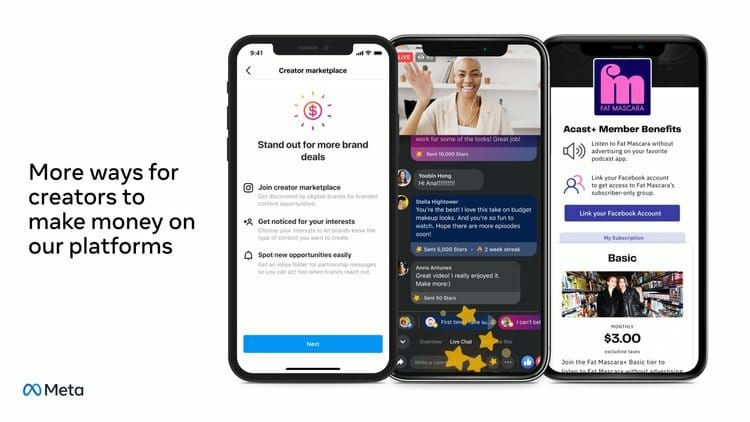
Meta announced several updates to creator monetization for Facebook and Instagram this week, including delaying the charging of creator fees for Subscriptions, Badges, Paid Online Events, and Bulletin until 2024. Among the other announcements are new monetization options and the expansion of existing ones.
Connecting Brands & Creators Through A New Creator Marketplace
Meta will start to test a Creator Marketplace where brands and creators can easily partner for branded content. Creators will be able to discover campaign opportunities and indicate brands and topics that they are interested in creating branded content for.
On the brand side, brands can find creators through the Meta Business Suite using demographics and filters for creators and their audiences. When they have identified creators they want to partner with, they can send them campaign details, including deliverables and payment information.
When creators post their branded content, permissions will automatically be granted for creators to tag the brand with the Paid Partnership label. Brands will also be granted boosting permissions automatically for deals that include paid media usage.
Allowing Creators To Give Off-Platform Subscribers Access To Facebook-Exclusive Features
For the first time, Meta will allow creators to give subscribers on other platforms access to Facebook-exclusive features via Interoperable Subscriptions. Starting with Interoperable Subscriber Groups, creators can offer subscribers access to subscriber-only Facebook Groups.
The first partners for Interoperable Subscriber Groups are Acast, an independent podcast company, and MemberPress, a WordPress membership plugin. Using Acast as an example, listeners of creators who use Acast+ can join subscriber-only Groups directly from the podcast feed, where they will be able to interact with the podcast host, engage with other listeners, and receive access to exclusive benefits such as live streams and Q&As.
Expanding Access To Stars, Reels Play & Digital Collectibles
More creators are getting access to Facebook Stars, the Reels Play Bonus Program, and Digital Collectibles.
Stars, a digital good that fans can purchase to send to creators to demonstrate their support, is now available in 22 markets to all eligible creators (at least 1,000 followers over the last 60 days) across Facebook Live, on-demand video, and eventually Facebook Reels.
Eligible U.S.-based creators (who have posted five original Reels and generated at least 100,000 plays in the last 30 days) can self-apply to be part of the Reels Play Bonus Program, which rewards creators for sharing original Reels content. Along with this, Meta is testing monetization for cross-posted Reels and a Paid Partnership label for branded content Reels so brands can amplify them as Branded Content Ads.
Lastly, Digital Collectibles, Meta’s NFT feature is being rolled out to more creators on Instagram and will soon be available in Instagram Stories with SparkAR and on Facebook.
A Continued Focus On Creators & Monetization
Meta shows its continued focus on creators through its latest creator monetization updates. Combining new tools such as the Creator Marketplace and Interoperable Subscriptions and expanded access to initiatives like Stars and Reels Play will allow more creators to earn money across Facebook and Instagram.
A More Active Role In Facilitating Branded Content Deals
Since branded content is a primary source of income for most creators, the Creator Marketplace will be quite valuable in helping creators make money through brand partners, without having to leave the Instagram app. Today, influencer marketing platforms and agencies play an important role in connecting brands and creators, but social media platforms such as TikTok, YouTube, and Snapchat have launched their own Creator Marketplaces in recent years to join in on the action.
Meta's biggest competitor, TikTok, has been working hard to build out its Creator Marketplace by launching new features, building out a dedicated team to support it, and opening API access to notable influencer marketing platforms and agencies. Despite the fact that many branded content deals happen on Facebook and Instagram, Meta has played a relatively passive role in facilitating these deals. With its own Creator Marketplace in place, it can take a more active role in helping brands and creators come together.
Helping Creators Provide More Value To Their Fans
Interoperable Subscriptions are perhaps one of the most surprising, yet exciting, features that Meta is launching. More creators are turning to content formats like podcasts and newsletters that are easy to build subscriptions on top of. However, to keep fans paying, creators often need to find new ways to provide value, which Interoperable Subscriptions can help with. This is something that is often done on Twitch with streamers giving live stream channel subscribers access to exclusive Discord servers.
Not only can creators provide more value to their paying subscribers across other channels with the new feature, but subscriber-only Groups are also a great way for creators to build community amongst their subscribers. The expansion of other partners such as membership and newsletter platforms will make the feature even more attractive to creators and their audiences, who will be able to get more value for their dollar.
Will Creators Care?
Regardless of what you think about Meta, Zuckerberg and the team aren't succumbing to TikTok, YouTube, or any other social media platform vying for creators. The pace at which Meta can churn out new monetization features for creators is impressive, even when they are copycat features from other platforms.
Creators might be happy about all the new ways they can make money on Facebook and Instagram. However, a question remains — can these outweigh some of the algorithm and app layout changes that the platform continues to make to the disappointment of creators.
Only time will tell, but for the time being, Meta is still an attractive platform to make money and run their businesses.
Industry News
Chinese influencers will now need a qualification to talk about highly professional topics. According to a new "code of conduct" for influencers published by the National Radio and Television Administration and the Ministry of Culture and Tourism, influencers who share content about certain topics, such as law, medicine, and finances, must hold a corresponding talk qualification. They then must show the qualifications to the live streaming platform for review and approval.
The "code of conduct" also prohibits live streamers from promoting content that "weakens or distorts leadership of the Chinese Community Party," using deepfake technology to tamper with party or state leaders, showing excessive food waste and luxury goods, or posting content that is sexually suggestive or provocative.
Creators that violate these rules risk being permanently banned from live streaming. Many of China’s most popular live streamers have faced punishment in recent months.
The latest rules are part of a big push by China to regulate live streaming across platforms such as Tencent, Alibaba, and ByteDance. In the last year and a half, it has put forth new regulations such as banning children under 16 years old from watching live streaming content after 10 p.m. and buying virtual gifts for creators.
China has a booming live streaming industry that generates an estimated 10 percent of its total e-commerce sales. With such tight restrictions and the high potential for creators to be banned due to violations, its economy could be impacted.
China’s recent regulations are a stark reminder that the creator economy can be a quite a different experience for creators in different parts of the world. Although many of its regulations are based on Chinese government policies, it makes you wonder if U.S. influencer regulations will ever be as strict. Probably not, but the idea of requiring creators to have some type of qualification in order to share content and advice on topics like medicine and finance doesn't seem so far-fetched.
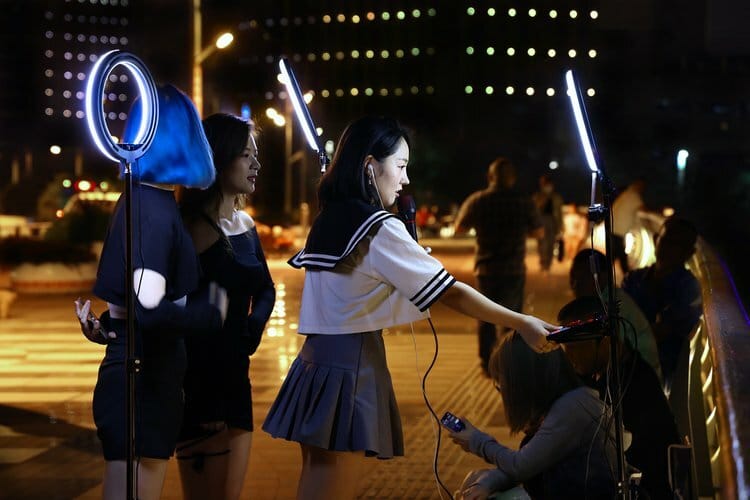
Twitter introduced Twitter Notes. This long-rumored feature allows creators to share long-form content that is readable on and off Twitter. With Notes, creators can go beyond the 280 character limit in a single piece of content by using a new composer tool, where they can combine text, photos, videos, GIFs, and Tweets. When Notes are published, they are distributed as Note Cards, which are Tweets with a preview of the Note and a unique link. Published Notes will also appear on creators' profiles under a new Notes tab.
Twitter is currently testing the feature with a select group of writers, including bloggers, newsletter publishers, comedians, content creators, social media managers, or “anyone else on Twitter who writes, has a profile as an opinion leader, or simply has something to say.”
This isn’t all. Along with the new feature is Twitter Write, a new team dedicated to developing tools and experiences that serve writers and readers.
Short-form writing is at the heart of Twitter. However, the platform is packed with long-form writing via threads and screenshots of blog posts or notes. In light of the demand for long-form writing, Twitter’s move to provide native support for the content is a good one.
Rather than relying on hacks to share longer writing or linking out to third-party platforms, Notes allows creators to write and share this kind of content directly on Twitter. Not only does this give creators another content format to use, but it also expands Twitter’s content library, which can drive up user engagement while making Twitter content more discoverable beyond its app.
It’s early, but Notes could pose a challenge for WordPress, Medium, Substack, and other long-form writing platforms since creators can tap into their existing audiences on Twitter.
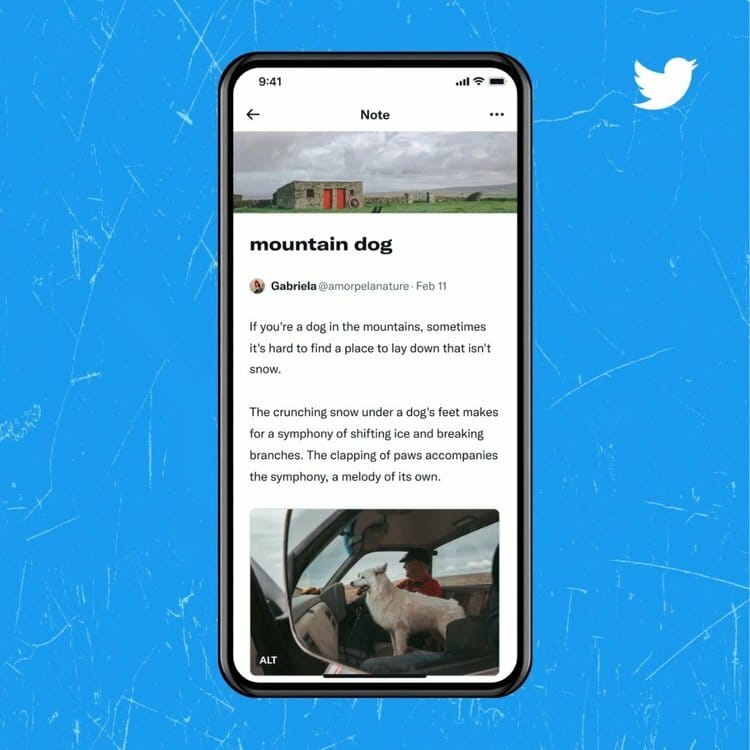
TikTok is making updates to its branded content policies. After more than a year of dialogue with the European Commission and other authorities around consumer protection, TikTok has committed to making several updates to its branded content policies.
Some of the key commitments TikTok has made are:
Allowing users to report ads and offers that could trick children into making purchases
Prohibiting the promotion of inappropriate products and services such as alcohol, "get rich quick" schemes, and cigarettes
Reviewing branded content videos by creators with more than 10,000 followers
Prompting creators to switch on the Branded Content Toggle when they add disclosures such as #AD or #Sponsored in the caption of their videos
Allowing users to report undisclosed branded content
In its response, the European Commission said it was satisfied with TikTok's commitment to improving transparency for branded content but remains wary of its impact since it feels TikTok didn't address its biggest concern, the targeting of children with personalized ads.
Even though TikTok's commitments aren't precisely what the European Commission was looking for, they should add more protection for consumers. For example, the Branded Content Toggle prompt and restrictions on branded content for certain categories have already been in place for some time. These have helped to encourage more creators to disclose branded content and discourage alcohol and cigarette brands from utilizing influencers to get in front of younger users on the app.
Other commitments like letting users report undisclosed branded content could further ensure that creators are properly disclosing content that is produced as part of a brand partnership. To me, this is one of the biggest areas of opportunities that platforms have failed to address. As I’ve previously written, it’s been quite surprising that this doesn’t exist, especially since users can already report content that believes violate copyright or platform guidelines. TikTok is the first to implement it, but it likely won’t be the last as more platforms face scrutiny from governance bodies that call on platforms to take more action.
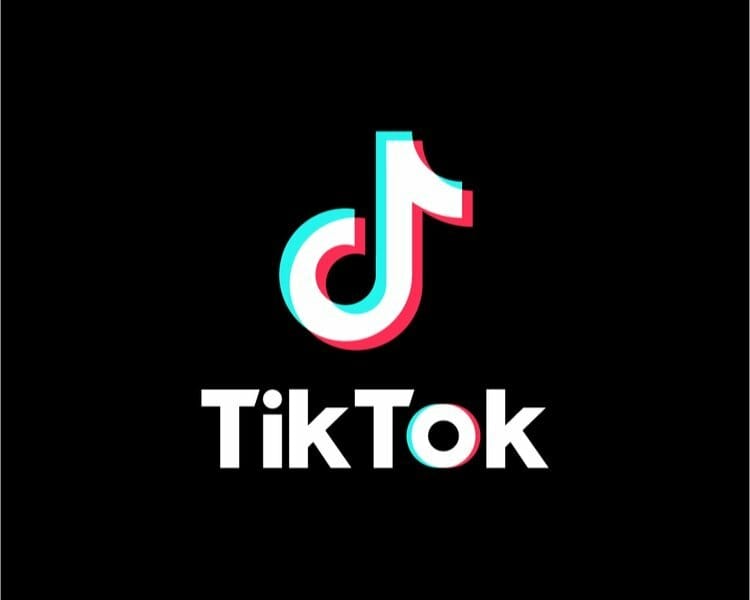
LinkedIn added a new way for reposts. LinkedIn is giving users the ability to share posts by creators through a new Repost button under the Share option on posts. The option lets users share the post across their feed without including any commentary. Any comments or reactions that stem from the repost are counted towards the original post. In addition, creators can see the number of reposts and who has shared it in their post analytics.
The feature functions similarly to Twitter’s Retweets, allowing users to quickly share content from others within their network. Native support reposts increase the chance that users will share more of the content they enjoy. As a result, creators can reach new audiences. Any engagement that results from reposts will be attributed to their original post, which helps to paint a more accurate picture of their content performance.

Notch, a creator start-up, offers creators the ability to get insurance for their Instagram accounts. As "the first insurance for digital assets," the company recently launched protection plans for creators’ Instagram accounts that include payouts in case they get hacked.
To sign up for Notch's insurance plans, creators first submit their handle and account size and answer a few questions about the account hacking history. After that, Notch generates a quote based on the creator’s account size, projected earnings, and local state taxes. The quote is broken down into three options featuring a monthly policy rate and what creators will be paid out daily if they cannot access their account.
In addition to payouts, Notch will support creators through real-time monitoring of their accounts and notifications when suspicious activity is detected. They will also provide a dedicated team to help creators retrieve their accounts if hacked. The company’s offering is currently available in Illinois, Arizona, and Florida, with plans to launch in more states in the coming months.
The rise of the creator economy has given birth to several companies focused on helping creators. Notch is one of these companies. As being a creator can be big business, creators need to be able to protect some of their most valuable assets – their social media accounts. For many creators, their social media accounts are the central piece to making money, whether through promoting products or services from brands or selling their own products or services directly to their audiences. For a small fee, creators can protect their prized assets and limit the potential negative impact an account hack or lockout may have on their livelihood and income.
With account hacking being quite a common occurrence today, creators being able to secure protection for their Instagram accounts can be pretty beneficial.
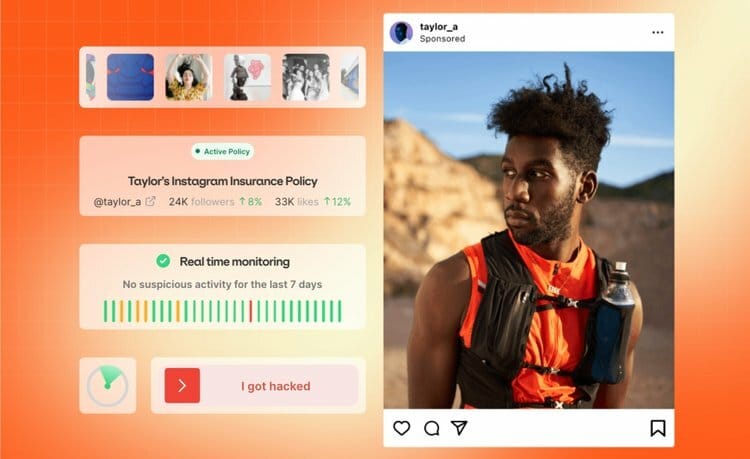
VSCO is rolling out VSCO Spaces. Through Spaces, creators can connect and collaborate through shared galleries and visual conversations. Creators can create and join Spaces around a particular theme, photography style, event, or location. In Spaces, they can engage in photo challenges, provide feedback on their photography, and discuss anything else they are interested in. Each Space is limited to 15 contributors as a way to encourage meaningful connections.
Spaces are equivalent to a digital co-working space, where creators can come together and share their work, support each other, and give feedback.
Spaces come at a time when more social media platforms are rolling out support for creators to collaborate with each such as Instagram's Collabs feature and TikTok's Duets. The difference between these features and Spaces is that Spaces focuses on building community rather than creating and sharing content together.
Spaces is part of a relaunch by VSCO and includes a new leadership team with Abode and Figma alum. It also includes product updates that cater to what it's calling "more serious creatives." Based on public statements, VSCO will likely start to explore how it can support creators beyond mobile devices.
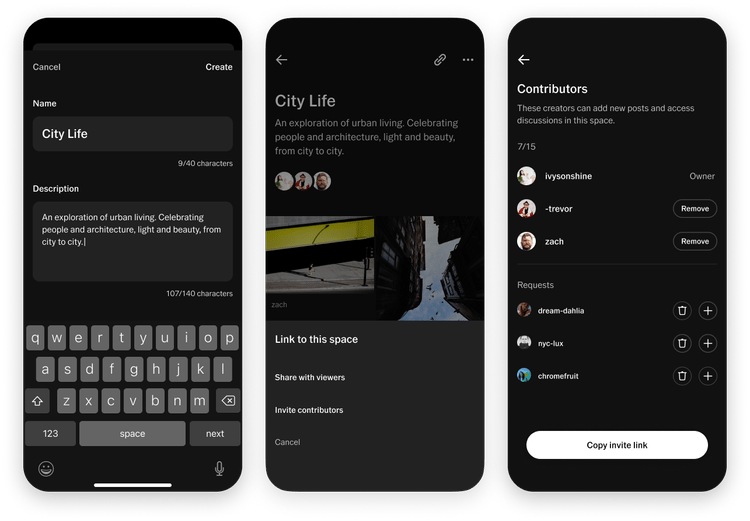
What I’m Reading
Khaby Lame unseats Charli D'Amelio as the most-followed account on TikTok (Mashable)
Host-read podcast ads mean the host, not the brand, is in control (Marketing Brew)
Influencers say brands are canceling ad deals and delaying payments as the market downturn hits the creator economy (Business Insider)
VidCon, where YouTube stars once caused stampedes, pivots to TikTok (NBC News)
The wild perks of social-media influencers include luxury hotels, private jets and even tax advice (New York Post)
